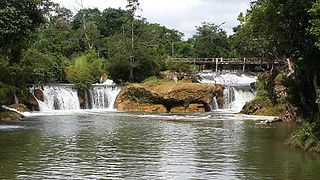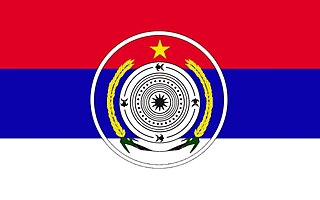
Kayah State, or Karenni State, is a state of Myanmar. Situated in eastern Myanmar, it is bounded on the north by Shan State, on the east by Thailand's Mae Hong Son Province, and on the south and west by Kayin State. It lies approximately between 18° 30′ and 19° 55′ north latitude and between 96° 50′ and 97° 50′ east longitude. The area is 11,670 km2 (4,510 sq mi). Its capital is Loikaw. The estimated population in the 2014 Myanmar Census was 286,738, the smallest among Myanmar's seven states. It is inhabited primarily by the Karenni ethnic group, also known as Red Karen or Kayah, a Sino-Tibetan people.

The Karen, also known as the Kayin, Kariang or Kawthoolese, are an ethnolinguistic group of Sino-Tibetan language-speaking peoples. The group as a whole is heterogeneous and disparate as many Karen ethnic groups do not associate or identify with each other culturally or linguistically. These Karen groups reside primarily in Kayin State, southern and southeastern Myanmar. The Karen account for around seven percent of the Burmese population. Many Karen have migrated to Thailand, having settled mostly on the Myanmar–Thailand border. A few Karen have settled in the Andaman and Nicobar Islands, India, and other Southeast Asian and East Asian countries.

The Karenni States, also known as Red Karen States, was the name formerly given to the states inhabited mainly by the Red Karen, in the area of present-day Kayah State, eastern Burma. They were located south of the Federated Shan States and east of British Burma.

The Karen National Liberation Army Burmese: ကရင်အမျိုးသား လွတ်မြောက်ရေး တပ်မတော်; abbreviated KNLA) is the military branch of the Karen National Union (KNU), which campaigns for the self-determination of the Karen people of Myanmar. The KNLA has been fighting the Burmese government since 1960s as part of the Karen conflict, which has been ongoing since 1949.

The Kayan are a sub-group of Red Karen, Tibeto-Burman ethnic minority of Myanmar (Burma). The Kayan consists of the following groups: Kayan Lahwi, Kayan Ka Khaung (Gekho)Kayan Kadao, Kayan Lahta, Kayan Ka Ngan. Kayan Kakhi and, sometimes, Bwe people (Kayaw). They are distinct from, and not to be confused with, the Kayan people of Borneo.

Insurgencies have been ongoing in Myanmar since 1948, the year the country, then known as Burma, gained independence from the United Kingdom. The conflict has largely been ethnic-based, with several ethnic armed groups fighting Myanmar's armed forces, the Tatmadaw, for self-determination. Despite numerous ceasefires and the creation of autonomous self-administered zones in 2008, many armed groups continue to call for independence, increased autonomy, or the federalisation of the country. The conflict is the world's longest ongoing civil war, having spanned more than seven decades.

The Shan State Army was one of the largest insurgent groups that fought government forces in Shan State, Myanmar (Burma). The SSA was founded in 1964 after the merging of two existing insurgent groups.
Nai Soi is a small village located in Mae Hong Son Province in northern Thailand. The village is under the administration of the Thai authorities. Nai Soi is about three kilometers from the Ban Mai Nai Soi Karenni refugee camp. Nai Soi is about 20 kilometers from the town of Mae Hong Son, along a paved road accessible year-round. It is perhaps most well known for the refugee camp found there and for having the largest Karenni settlement of the three villages. Thai authorities view Ban Mai Nai Soi as a self-sustaining refugee camp.

The Kayan New Land Party is a political party in Myanmar. Its armed wing is Kayan New Land Army.

Mae La, Beh klaw, is a refugee camp in Thailand. It was established in 1984 in Tha Song Yang District, Tak Province in the Dawna Range area and houses 50,000 Karen refugees; the number continues to rise as of June 2019. Mae La is the largest refugee camp for Karen refugees in Thailand. Over 90% are the persecuted ethnic Karen. The camps are overseen and run by the Thailand Burma Border Consortium (TBBC), a union of 11 international non-governmental organizations that provide food, shelter and non food items to the Burmese refugees and displaced people.
Ceasefires in Myanmar have been heavily utilized by the Burmese government as a policy to contain ethnic rebel groups and create tentative truces. The first ceasefire was arranged by the State Law and Order Restoration Council in 1989, specifically spearheaded by Khin Nyunt, then the Chief of Military Intelligence, with the Kokang-led National Democratic Alliance Army, which had recently split from the Communist Party of Burma due to internal conflicts.

The Karen conflict is an armed conflict in Kayin State, Myanmar. It is part of the wider internal conflict in Myanmar between the military government and various minority groups. Karen nationalists have been fighting for an independent state, known as Kawthoolei, since 1949. The Karen National Union (KNU) and its Karen National Liberation Army (KNLA) are the most prominent Karen rebel groups. Hundreds of thousands of civilians have been displaced by the conflict, many of whom fled to neighbouring Thailand and survive in refugee camps.

The Mon National Liberation Army is a Mon insurgent group in Myanmar (Burma). It is the armed wing of the New Mon State Party (NMSP), and has been fighting government forces since 1949, though under different names. The NMSP signed the Nationwide Ceasefire Agreement (NCA) on 15 October 2015 with several other insurgent groups and the government of Myanmar.
The Fall of Manerplaw occurred on 27 January 1995, when the village of Manerplaw was captured by the Tatmadaw and the Democratic Karen Buddhist Army (DKBA). Manerplaw was the headquarters of two armed opposition groups, the Karen National Union (KNU) and the All Burma Students' Democratic Front (ABSDF). The final military assault by the Tatmadaw, aided by positional information provided by the DKBA, was met with little resistance by the KNLA, whose leaders had ordered a tactical retreat.

Naw K'nyaw Paw is a Karen peace activist who works for women's rights in Myanmar. She is the General secretary of the Karen Women’s Organisation, and won an International Women of Courage Award in 2019.
Huay Pu Keng is a village located in the province Mae Hong Son, in the northwest of Thailand. The village is inhabited by the Tai Yai, a Thai ethnic community and four subgroups of the Karenni people, namely the Kayan, Kayaw, Red Karen and Pakayor. The Kayan women in particular became famous because tourists began to find interest in their long necks with brass rings.

The Myanmar civil war, also called the Burmese Spring Revolution, Burmese civil war or People's Defensive War, is an ongoing civil war following Myanmar's long-running insurgencies, which escalated significantly in response to the 2021 military coup d'état and the subsequent violent crackdown on anti-coup protests. The NUG and major ethnic armed organisations repudiated the 2008 Constitution and called instead for a democratic federal state. Besides engaging the rebels, the junta also contends with anti-junta forces in areas under its control.
The Battle of Mese took place during the first half of 2023 for control of Mese Township on the border between Myanmar and Thailand in Kayah State. The battle was a part of the current Myanmar civil war.












